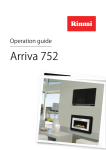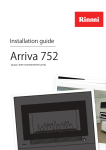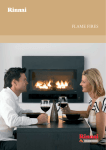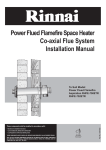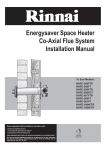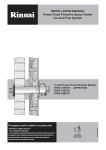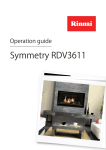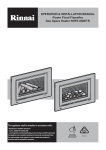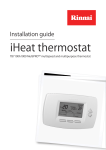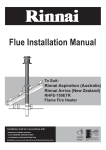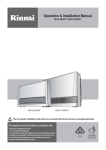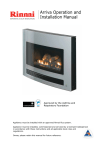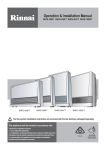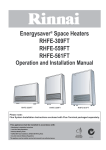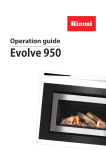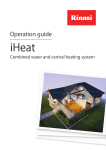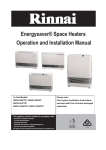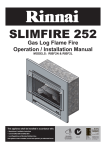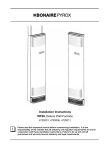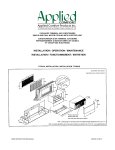Download Rinnai Arriva Installation guide
Transcript
Installation guide Arriva 750 Models: RHFE750ETRN/RHFE750ETRL Important: Appliance must be installed with a Rinnai approved flue system. This appliance shall be installed in accordance with: -- Manufacturer’s installation instructions -- AS/NZS 5601.1 -- Local regulations and municipal building codes Installation, servicing and repair shall be carried out only by authorised personnel. Warning Improper installation, adjustment, alteration, service or maintenance can cause property damage, personal injury or loss of life. For more information about buying, using, and servicing of Rinnai appliances call: 0800 RINNAI (0800 746 624). Rinnai New Zealand Limited 105 Pavilion Drive, Mangere, Auckland PO Box 53177, Auckland Airport, Auckland 2150 Phone: Email: (09) 257 3800 [email protected] : s t n e cont Specification..................................................... 4 Clearances........................................................ 5 Location........................................................... 6 Gas connection................................................ 7 Flueing options................................................. 8 Flueing guidelines............................................ 9 Arriva flue components.................................... 10 Flue transition................................................... 12 Installation........................................................ 13 Installing the log set......................................... 14 Commissioning................................................ 15 Setting the air guide vane................................ 15 Panel installation.............................................. 16 Flame pattern................................................... 17 Installation checklist......................................... 18 Wiring diagram................................................. 19 Specification Flat Front 230 845 675 660 365 90 900 365 Glass Front 230 845 675 365 660 126 900 365 Dimensions are in mm. Arriva 750 Specification summary Input = 8-31.5 MJ/h Output = 1.8-7.0* kW Efficiency = 80% (on high) Heating area = 70-95 m²** Gas type = NG or LPG Inbuilt convector ceramic log space heater with forced convection and power flue system. Suitability Ideal for living rooms and open plan areas. Versatile power flue system makes for easy installation in almost any living space, including bedrooms. The Arriva is ideal for new build installation into a false (mock) chimney, but can be fitted into an existing masonry fireplace if it is big enough. Dataplate Inside appliance, upper right hand side (beside convection fan). Fan type 3-speed (high, medium, and low) radial blower fan. Flue Power flue, inner - 50 mm, outer - 78~80 mm. Appliance must be installed with a Rinnai flue system. Gas connection ½ “ BSP male flare to barrel union (lower right hand side of appliance). Ignition Continuous spark electronic ignition. Installation considerations Room size—smaller rooms will heat up quickly, and due to the efficiency of the appliance, the heater (if auto off is selected) will turn to a low flame setting once the set temperature has been reached. Power consumption High 90 W, low 60 W, and standby 10 W. Standard electrical connection is to the right hand side of the appliance. Safety devices Flame failure sensing system, pressure relief, overheat safety switch, air temperature sensor, thermal fuse, overcurrent fuse, and spark detector. Temperature control Thermostatic, temperature control range 16-26 °C. Weight 70 kg Noise level 33-41 dB(A) * Will vary according to gas type and flue configuration ** Will vary depending on geographical location in NZ 4 | Arriva 750 Installation Guide: 10473-C 03-13 Clearances The clearances listed below are minimum clearances unless otherwise stated. Clearances around the heater The appliance must not be installed where curtains or other combustible materials (coffee tables, couches etc.) could come into contact with the heater. In some cases curtains may need restraining. Floor protection Heat emanating from this fire may over time affect the appearance of some materials used for flooring, such as, carpet, vinyl, cork or timber. This may be amplified if the air contains cooking vapours or cigarette smoke. To avoid this occurring, it is recommended that a mat be placed in front of the appliance. 250 mm 100 mm 100 mm 1000 mm Clearances required around the heater when operating Mantels and surrounds Mantels and surrounds are allowed providing they conform to the minimum clearances shown. These clearances are important as they: -- allow heat to escape in the event of a power failure during operation -- allow optimum performance of the heater (room air return) -- allow access to the side mesh filters Mantel clearance calculation example At a 75 mm vertical clearance, the maximum mantel depth is 25 mm. For every 25 mm of added mantel depth, there must be an additional 25 mm of vertical clearance. For example a mantel depth of 100 mm requires a vertical clearance of 150 mm. Arriva mantel clearances Arriva surround clearances Arriva 750 Installation Guide: 10473-C 03-13 | 5 Location The main points governing location are flueing and warm air distribution. The Rinnai Arriva has a cool outer casing, it can be installed into an existing masonry, or decorative fireplace. Enclosure dimensions The heater must be positioned on a flat level surface that allows free movement of the appliance. A pair of wheels located at the rear of the heater allows the unit to slide in and out of the enclosure for commissioning and maintenance. w h d In a masonry fireplace use a slurry of sand and cement to level the base as required. Enclosure dimensions In a decorative fireplace, when the appliance is elevated from the ground, construct a base using a board with supporting joists as pictured. W-width 850-860 mm H-height 660-665 mm D-depth 380 mm direct flue 475 mm extended flue 500 mm underfloor flue All dimensions provided are critical to the installation of this appliance and must be strictly adhered to. Left and right wheels Joist MDF board, minimum 20 mm Joist 720 Elevated installation in a decorative fireplace 6 | Arriva 750 Installation Guide: 10473-C 03-13 Gas connection Gas pipe sizing must consider the gas input to this appliance, as well as other gas appliances in the premises. The gas supply termination is inside the heater, and enters from the rear right hand side of the appliance. To ensure correct positioning terminate the gas supply so it is 80 mm in from the front face of the enclosure opening. 80 mm of ar re e R osu cl en Direct flue wall penetration requirements Use the guide pictured to mark the penetration points for the gas supply and flue transition locations. Consideration must be given to the position of any studs, noggins or other components of the wall structure on both sides of the wall. Fro nt of enc los ure Purging gas supply Foreign materials and debris such as swarf, filings etc. must be purged from the gas supply. Failure to do so may cause damage to the control valve causing it to malfunction. Correct positioning of the gas supply Flue pipe penetration Centreline of enclosure Mark these measurements accurately as this is critical to a successful installation. 580 ± 25 The penetration for the flue transition only needs to be made for direct flue installations, where the terminal is to be terminated directly to the rear of the appliance. Ø 85~95 Gas supply penetration 378 400 55 All dimensions are in mm. Direct flue wall penetration points Arriva 750 Installation Guide: 10473-C 03-13 | 7 Flueing options Rear external wall Vertical B A A False wall False wall Sideways through wall Through wall B False wall Flue components: - Direct A flue (R2731), or - Direct B flue (R2732), or - Direct flue (ASPDFK) A flue components: - Adaption flue (ASPKIT03) - Coaxial pipe (ESPIPE900) - Roof cowl (ESROOFCOWL) This flue configuration could be up to 8.5 m long (no bends). A flue configuration could have a flue length of 7 m and contain one 90° bend—the 90° bend would A flue configuration could have be the flue transition (ASPKIT03). a flue length of 7.5 m and contain one 90° bend—the 90° bend B flue components: would be the 90° bend (ESBEND). - Adaption flue kit (ASPKIT03) - Coaxial pipe (ESPIPE900) B flue components: - Bend 2 x 45° (ESBEND x 1) - Direct flue (ASPDFK) - Roof cowl (ESROOFCOWL) - Coaxial pipe (ESPIPE900) - Bends 2 x 90° (ESBEND x 2) B flue configuration could have a - Condensate trap (ESCONDK) flue length of 6.5 m and contain two bends—the first 90° bend would be the flue transition B flue configuration could have a (ASPKIT03), and the second 90° flue length of 6.5 m and contain bend would be the two 45° bends two 90° bends—the bends would (ESBEND). be the two 90° bends (ESBEND). Down and out Flue components: - Adaption flue (ASPKIT03) - Coaxial pipe (ESPIPE900) - Bend 2 x 45° (ESBEND x 1) - Wall terminal (ESWTERM) A flue components: - Direct flue (ASPDFK) - Coaxial pipe (ESPIPE900) - Bend 1 x 90° (ESBEND x 1) - Condensate trap (ESCONDK) - Roof cowl (ESROOFCOWL) Flue components: - Adaption flue (ASPKIT03) - Coaxial pipe (ESPIPE900) - Wall terminal (ESWTERM) ASPDFK, remove terminal and use on outside wall. Flueing notes For all installations an Arriva flue system MUST BE used. Detailed flue instructions are provided with Arriva flue kits. Termination point Flue is not to terminate under floors or in a roof space. Exterior wall Flue terminal Under floor Flue terminal Exterior wall Heater 8 | Arriva 750 Installation Guide: 10473-C 03-13 Heater Condensate A condensate trap is required for ALL vertical flue installations to ensure condensate generated during combustion is trapped and prevented from entering the chamber of the heater. For horizontal, and down and out installations, there must be a continuous fall of at least 2°. This equates to approximately 20 mm per metre to the termination point to drain the condensate. For direct flueing, direct flue kits A and B have an inbuilt 2° fall. Masonry The Arriva must not be flued into natural draft cavities. Down rating the appliance For all Arriva flueing EXCEPT direct flueing, the appliance must be down rated (ensures optimum performance of the fan) as per the instructions on the commissioning sheet. Maximum flue length and number of bends • Max. flue length - 8.5 m • Max. number of bends - three One 90° bend equals 1 m. For every 90° bend the overall length must be reduced by 1 m. For example if an installation has three 90° bends, the maximum flue length can be 5.5 m. The flue transition for all flueing installations, excluding direct horizontal flueing, is counted a 90° bend. Flueing guidelines Every gas fireplace requires a flue system that will draw effectively and clear flue products safely under all potential wind and climatic conditions. It is the responsibility of the installer to ensure that the appliance is provided with an effective flue. Some guidelines to assist with flue design are listed below. These must be read and modified as necessary with reference to the particular installation. The Rinnai Arriva must be installed with an approved Rinnai flue system. Approved flue components for this appliance are detailed in this guide. Clearance to combustibles • Flue transition (p. 12) - 5 mm • Elbow component of adaption flue kit (ASPKIT03) - 25 mm Vertical terminations: Flue cowl clearance To ensure products of combustion are cleared, adequate clearance from the building is required. The flue cowl should have a 500 mm clearance from any part of the building. This also applies to steeped and pitched roofs which should be clear of the ridge line. Lesser clearances may provide perfectly adequate flue systems depending on the installation. Minimum clearances are shown in AS/NZS 5601.1. Minimum clearance 500 mm to nearest part of roof All other Arriva flue components have zero clearance. Flashings Flashings to top of chimney structure do not form part of the flue kit and must be specified. Flue support The weight of the flue system should not be supported by the appliance—it should be self-supporting. Supporting the flue is usually completed during the framing stage with flue supports or straps within the cavity. Shared flues Gas appliances must not be connected to a chimney or flue serving a separate fuel burning appliance. Arriva 750 Installation Guide: 10473-C 03-13 | 9 Arriva flue components Direct A flue kit Direct B flue kit Direct flue kit Code Code Code = R2731 = R2732 For use in walls 115-240 mm thick— typically weatherboard construction (can be cut to size). This is a complete kit, no other components are required. For use in walls 240-400 mm thick— typically block construction (can be cut to size). This is a complete kit, no other components required. • • • • Stainless steel Inbuilt 2° fall to drain condensate Stainless steel Inbuilt 2° fall to drain condensate = ASPDFK For use in walls greater than 400 mm (can be cut to size). Can be used in combination with ESPIPE900 for longer flueing. Kit includes flue slide stopper (part 4822). Flue terminal section is reusable when making flue longer. Flue is aluminium, collars are PVC, and spacers are PBT plastic. Long End Condensate tray Short End Condensate drain hose Barb (top) Condensate Tube Wire Tie 90° Bend Arriva adaption flue kit Condensate drain kit Coaxial flue pipe 900 mm Code Code Code = ASPKIT03 Used for all flueing configurations EXCEPT standard direct flueing. Elbow section of this component (circled) requires a 25 mm clearance from combustibles, the rest is zero clearance. This kit also contains a sub-kit called the condensate drain kit (shown in next panel), and the flue slide stopper (part 4822). 10 | Arriva 750 Installation Guide: 10473-C 03-13 = R1970 The condensate drain kit is provided with ASPKIT03. It is used for internal wall flue installations, or other vertical flue installations that will require draining of condensate back into the heater. = ESPIPE900 Extension pipe (960 mm installed) used to construct horizontal, vertical, and downwards flueing. Can be cut to size. Inner is aluminium, and outer is PVC plastic. Comes with one wall bracket. • • O-ring for ESPIPE (4350) Spacer for ESPIPE (4351) 120 Ø 80 120 Ø 75 Vertical terminal Condensate trap 45° flue bends x 2 Code Code Code = ESROOFCOWL Roof cowl and connecting pipe (960 mm installed) for termination of flue—can be cut to size. Powder coated (black) galvanised steel construction. = ESCONDK For the small number of vertical through-wall flue installations, where the Arriva is installed against a solid brick wall, or where the direct flue terminal cannot be used. Used in conjunction with; ASPDFK, ESBEND, ESPIPE900, and ESROOFCOWL. = ESBEND Two 45° bends used to facilitate between horizontal, vertical, and downwards flueing. Can be used separately, or together as one 90° bend. Two spacers included. External wall plate Ø 170 mm Flue terminal 22mm x6 7mm x2 Mounting/securing screws Wall terminal kit Flue guard Universal wall plate Code Code Code = ESWTERM Used to terminate the flue pipe (ESPIPE900) in horizontal flue installations when used in conjunction with ASPKIT03. = R1370 Protection against hot flue gases when the flue terminates low to the ground. = ESPLATE Used if an extra wall cover plate is required to tidy any installation work through the wall, ceiling, or floor. Colour - warm white. Contains: • External wall plate (PVC) • End cap (aluminium) Arriva 750 Installation Guide: 10473-C 03-13 | 11 Flue transition The flue transition provides a connection between the flue system and the heater’s flue spigot and air intake. For all flueing installations, except horizontal direct flueing, the flue transition is counted as a 90 ° bend. Air Inlet R EN EAR CL O OS F UR C EN E E R SU LO The enclosure depth for a down and out installation is 500 mm to allow the flue pipe to clear the base of the appliance. m 380 m Horizontal direct flue transition Appliance needs to be down rated—refer data plate. Air Inlet Flue Outlet TO ON R EN EAR CL O OS F UR 5 mm FE 47 E RE SU LO NC Flue transition components The flue transition is comprised of: -- transition flue outlet -- transition air inlet -- wall plate FR Vertical flue transition Transition flue outlet Transition air inlet Wall plate Air Inlet Flue Outlet FE TO ON FR Vertical flue transition When installed as a vertical direct flue, the flue transition is fastened to the rear wall by standoff brackets supplied. OF Horizontal direct flue transition When installed as a horizontal direct flue, the flue transition is pushed hard against the internal wall plate, which is pushed hard against the rear wall of the enclosure as shown. Flue Outlet NT In all cases when positioned correctly the flue transition connection must protrude 110 mm from the rear of the enclosure. Down and out flue transition When installed as a down and out flue, the flue transition is fastened to the rear wall by standoff brackets supplied. O FR The flue transition requires a 5 mm gap from combustibles. This clearance is provided automatically when the supplied standoff brackets are used. All other flue components, except the elbow section of the adaption flue kit are designed for zero clearance and can be placed hard against timber or plasterboard. m NC Elbow component of the adaption flue kit requires a 25 mm clearance to combustibles. E RE SU LO 500 m R EN EAR CL O OS F UR Offset flue transition Appliance needs to be down rated—refer data plate. Air Inlet Flue Outlet TO ON FR LO NC FE Offset flue transition When installed as a vertical or horizontal offset flue, the flue transition is fastened to the rear of the wall by standoff brackets supplied. m 500 m R EN EAR CL O OS F UR E R SU E Appliance needs to be down rated—refer data plate. 12 | Arriva 750 Installation Guide: 10473-C 03-13 Down and out flue transition Arriva 750 installation WARNING Isolate the electrical supply before removing any panels. differ depending on the flue configuration. Installation overview 1. Connect to gas pipe 2. Open flue & air hose access 3. Connect flue pipe 4. Install heater engine 5. Secure heater 6. Check all connections d. Fasten air inlet hose to transition box using cable tie supplied in accessory pack with the remote. 1. Connect to gas pipe a. Remove the right hand side access panel by removing the four retaining screws. f. Replace flue access panel. b. Extend flexible gas connection through the gas fitting access point to the outside of the heater body. c. Position the appliance in front of the enclosure so the end of the gas pipe aligns with the gas fitting access point. d. Securely connect flexible gas connection to the gas pipe, testing all connections for gas leaks. e. Replace right hand panel and secure screws in place. 2. Open flue & air hose access a. Unscrew the flue access panel. b. Remove the clamp that secures the telescopic vertical flue pipe to the telescopic horizontal flue pipe. c. Clamp the horizontal flue pipe to the flue transition box using either the flue retainer bracket (supplied in the plastic bag with the remote control), or the flue slide stopper (provided with the ASPDFK and ASPKIT03 flue kits). The clamping component will Side panel Screws 1a: Remove right hand access panel e. Push appliance into position. Adjust horizontal and vertical telescopic flue pipe, and connect using clamp. Screws Access panel 3. Connect flue pipe Connect flue pipe to flue and hold in place using appropriate clamp. Failure to secure the flue system using the supplied clamps may result in a dangerous situation. 2a: Unscrew flue access panel Telescopic horiz. flue pipe 4. Install heater engine Carefully move the heater into the enclosure cavity ensuring the gas pipe and flue transition are aligned with their access openings. As the appliance is pushed into place ensure the flexible gas connection coils freely inside the appliance, and that the gas pipe penetrates through the centre of the gas access point. 5. Secure heater Secure the heater, using appropriate fixings, through the four appliance mounting points— two upper and two lower (on each side of the appliance). Lower elbow Clamp Telescopic vertical flue pipe 2b: Remove clamp from flue pipe Air inlet hose Telescopic horiz. flue pipe Transition box Flue slide stopper (ASPDFK & ASPKIT03) Clamp Telescopic vertical flue pipe 2c/d: Fasten horiz. flue pipe and air inlet hose 6. Check all connections Check all connections are properly engaged and are inserted beyond the O-ring seal. Appliance mounting points 5: Secure heater Arriva 750 Installation Guide: 10473-C 03-13 | 13 Installing the log set Before the log set can be installed the combustion chamber glass panel needs to be removed. 1. Remove the two retaining screws that secure the combustion chamber glass panel to the heater engine. Retaining screws Rear main log Combustion chamber glass Centre top log Right hand front log Right hand top log Right hand bottom log Left hand front log 1. Removing combustion chamber glass 2. Arriva 750 log set assembly 3. Placing the rear main log 4. Placing the left and right hand front logs Rotate and lift the combustion chamber glass clear of the combustion chamber and place in a safe location until required. 2. Remove the log set—made up of seven pieces: - rear main log - right hand front log - right hand top log - right hand bottom log - left hand front log - centre top log - left hand bottom log 3. Place the rear main log into the combustion chamber on the rear location pins. Centre top log Right hand top log 4. Place the left hand and front hand logs into the combustion chamber on the locating pins. 5. Place the centre top log over the main log and right hand front log. Secure on the central locating pin of each log. Repeat step with the right hand top log, securing the log in the locating pins on the right hand side. Flam e 5. Placing the top logs 6. Place the left hand bottom log onto the combustion chamber so that it hides the flame sensor rod from view. Place the right hand bottom log on the opposite side. 7. Replace the combustion chamber glass panel and secure in place with the two retaining screws. 14 | Arriva 750 Installation Guide: 10473-C 03-13 6. Placing the right hand bottom log sens or ro d 6. Placing the left hand bottom log Commissioning The gas pressures of the appliance are factory preset for direct flue installations and will normally not require adjustment. For all Arriva flueing EXCEPT direct flueing, the appliance must be down rated as per the instructions on the commissioning sheet. The commissioning sheet is located in a plastic pouch behind the removable access panel on the right edge of the combustion chamber glass panel. Follow the commissioning instructions to complete the gas pressure adjustments, and ensure correct operation of the appliance. Commissioning sheet position Setting the air guide vanes The air guide vanes allow the installer to set and adjust the horizontal air flow distribution of the appliance. These are not to be confused with the horizontal louvres that determine the direction of the vertical flow— these are fixed and cannot be adjusted. The air guide vanes can be adjusted by carefully bending to the left or right using a screwdriver. -- Do not adjust the vanes more than five times as this may cause the metal to fracture and/or break. -- Do not attempt to adjust the air flow direction while the appliance is operating or still hot as this could result in a burn injury. Arriva 750 Installation Guide: 10473-C 03-13 | 15 Panel installation Always inspect the glass for any chip or obvious sign of damage before installation. Care is required when handling the front fascia—no sudden impact or excess force should be applied. Glass panels Always wear gloves and safety glasses when handling glass. Installing the front panel Install the fascia panel by hooking the top to the body and rotating the bottom in towards the appliance body. Secure the fascia to the appliance body, with the two retaining screws, through the front of the warm air discharge louvre. Installing the front panel Installing the top panel Push the top panel down into place and secure with the screws provided. Installing the top panel 16 | Arriva 750 Installation Guide: 10473-C 03-13 Flame pattern It may take approximately two hours of operation for the logs to achieve their full flame pattern and glow. During the initial burning in period, some smoke and smell may be experienced. The appliance should run on the high setting in a well ventilated room until these dissipate. It is important to check the flame pattern during this time. Abnormal flame pattern Abnormal flame performance and/ or pattern can indicate a problem with your fire, such as blocked gas injectors, or that the burn media has shifted from when the fire was first installed. There are some warning signs that could indicate a problem. -- Unusual smell from the appliance -- Continued difficulty or delay in establishing a flame -- Flame appears either very short or very long -- Flame only burns part way across the burner -- Severe soot building up on the inside of the glass door Normal flame pattern Abnormal flame pattern Important It is the responsibility of the installer to check that under normal conditions of the appliance, all flue gases are exhausted to the outside atmosphere, and that there is no spillage of combustion gases into the room. If the appliance cannot be made to perform correctly please contact Rinnai. Arriva 750 Installation Guide: 10473-C 03-13 | 17 Installation checklist Complete the installation checklist in the customer operation guide, and make sure you leave the guide with the customer. Explain to the customer about the use and care of the unit, and ensure they understand the instructions and operation of the appliance. 18 | Arriva 750 Installation Guide: 10473-C 03-13 Wiring diagram (part of commissioning sheet) Mark bk bl gr/y gy or pl r w y Colour Black Blue Yellow - Green Stripe Grey Orange Purple Red White Yellow Mark Part Mark Part MS Main Switch OH.TH1,2 Over Heat Thermistor 1, 2 R.TH Thermistor SV1~4 Main Solenoid Valve 1~4 TF Thermal Fuse BL Combustion Fan Motor F Fuse FCC Fan Control Circuit ER Electrode RCR Remote Control Circuit POV Modulating Solenoid Valve CPU Central Processing Unit TR Transformer PB Pilot Burner FR1~4 Flame Rods 1~4 FB Front Burner RC Remote Controller REARB Rear Burner CF Convection Fan REARB (L) Rear Burner Left FM Convection Fan Motor REARB(R) Rear Burner Right SP Sparker Arriva 750 Installation Guide: 10473-C 03-13 | 19 Experience our innovation Rinnai.co.nz 0800 746 624 http://www.youtube.com/rinnainz




















